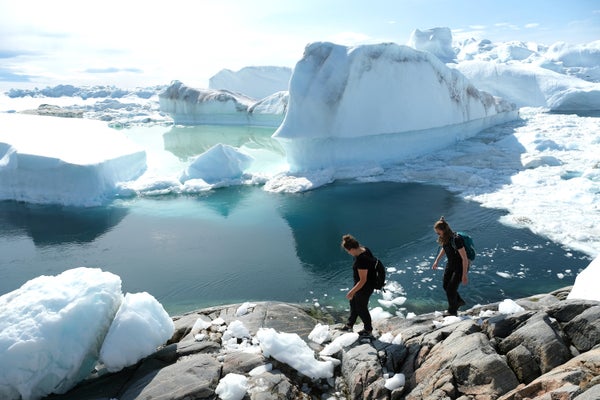Some of the coldest parts of the Greenland ice sheet have hit their warmest levels in at least a millennium — and the amount of melting they’re experiencing has also probably hit a thousand-year high.
The findings in a new study underscore a grim trend for the world’s second-largest ice sheet. Temperatures are steadily rising, the ice is gradually shrinking and the world’s frozen places are vulnerable to the steady march of climate change.
The study, published Wednesday in the journal Nature, reconstructs 1,000 years of Greenland climate history using enormous ice cores carefully drilled out of the ice sheet.
On supporting science journalism
If you're enjoying this article, consider supporting our award-winning journalism by subscribing. By purchasing a subscription you are helping to ensure the future of impactful stories about the discoveries and ideas shaping our world today.
Greenland contains some of the world’s oldest ice, frozen in place for hundreds or thousands of years. The ice contains trapped air bubbles and other chemical signatures that offer clues about what the climate was like when the water froze. Scientists can compare older ice with layers of newer ice to determine how the region’s climate has changed over time.
For this study, the researchers drilled in north-central Greenland — one of the ice sheet’s coldest and highest-elevation regions. The ice cores contain information extending all the way up to 2011 and 2012 when they were extracted from the ice sheet.
They suggest that temperatures between 2001 and 2011 were around 1.5 degrees Celsius higher than the 20th-century average. And they were “exceptional” for the entire 1,000-year study period.
Under the Paris climate agreement, nations are striving to keep global warming well below 2 C and below 1.5 C if at all possible. These are global targets, referring to temperatures averaged across the entire world — some places will warm faster and others slower.
The new study indicates that one of the world’s coldest and iciest regions has already hit that threshold. And by the time the global average reaches 1.5 C — which could be within a decade or so — Greenland’s temperatures will likely soar even higher.
This region of Greenland is known to have high levels of natural variability, meaning temperatures have fluctuated up and down over the years. But the new study now finds an unambiguous signal of human-caused warming in one of the ice sheet’s coldest corners, entirely standing out from the natural variations of centuries past.
“Although grimly expected in the light of global warming, we were surprised by how evident this difference really was,” said Maria Hörhold, a glaciologist at the Alfred Wegener Institute, Helmholtz Centre for Polar and Marine Research, and lead author of the study.
The study also finds that the amount of liquid water produced by melting ice has increased in north-central Greenland alongside rising temperatures. The meltwater findings are a bit less certain than the temperature findings, but the researchers say that the melt rates are likely also “unprecedented” within the last thousand years.
That’s no surprise to the scientists. Researchers have observed an increase in the areas affected by melt events across Greenland in recent years, including some of the ice sheet’s highest and coldest regions.
In August 2021, researchers were stunned to observe rain for the first time on record at Greenland’s Summit research station, the highest point on the ice sheet. It’s so cold there that it typically only sees snow. The rain came in the midst of a record-breaking melt that researchers say was the largest such event to hit the ice sheet so late in the year.
Greenland has seen a number of other record-breaking melt events in recent years, some of which caused melting — although not rain — at Summit Station. These included major melting incidents in 2019 and 2012.
More frequent and more intense melt events are a serious cause for concern in Greenland. They can increase the amount of meltwater running off the ice sheet and into the ocean, raising global sea levels.
The new findings are in keeping with long-term trends across the Greenland ice sheet.
The findings, the researchers write, “demonstrate that global warming is now also detectable in one of the most remote regions in the world.”
Reprinted from E&E News with permission from POLITICO, LLC. Copyright 2023. E&E News provides essential news for energy and environment professionals
